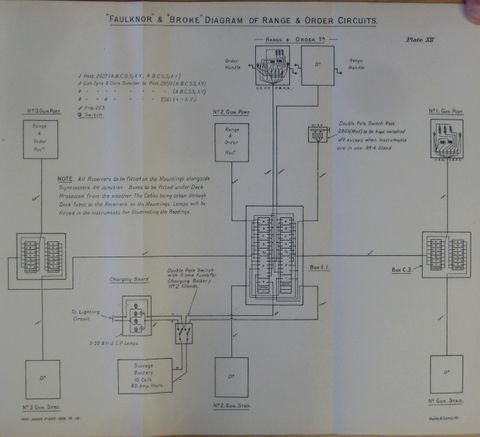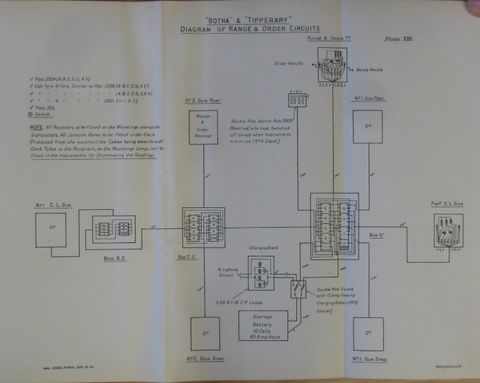Difference between revisions of "Faulknor Class Flotilla Leader (1914)"
(better names for the footer sorting sets) |
(Use new footers for ship classes) |
||
| Line 45: | Line 45: | ||
{{refend}} | {{refend}} | ||
| − | {{Faulknor Class (1914)}} | + | {{Footer Faulknor Class Flotilla Leader (1914)}} |
{{DEFAULTSORT:Faulknor}} | {{DEFAULTSORT:Faulknor}} | ||
Revision as of 16:20, 9 September 2012
The four flotilla leaders of the Faulknor Class were completed between 1914 and 1916.
Machinery
Generators
In 1916, it was stated that flotilla leaders have two 26.25 kw dynamos arranged in parallel with an additiona 9 kw oil-fired set for emergency use.[1] It is likely but not certain that this applied to this earlier class.
Armament
4-in Guns
The ships carried six 4-in QF Mark VI 45cal guns[2][3] on P XI mountings.[4] In March, 1918, four of Broke's 4-in guns were replaced by two 4.7-in BL guns on CP VI mountings. The other ships were later similarly equipped.[5]
Other Guns
One 1-pdr (or 1.5-pdr) HA gun and two .303-in Maxim machine guns.[6][7] In Botha and Tipperary, at least, the 1.5-pdrs were later replaced by 2-pdrs Mark I.[8]
When three of the ships served at Dover after the loss of Tipperary, their 4-in guns were outranged by German destroyer guns, prompting the exchange in March 1918 of two 4.7-in BL Mark I guns on CP VI mountings capable of 30 degree elevation for the fore and aft 4-in weapons. With a range of 16,000 yards as opposed to 12,000, the ships were much more dangerous, but weight considerations prevented a complete change to 4.7-in guns.[9][10]
Plates XII and XIII in the Handbook of Fire Control in Torpedo Boat Destroyers of "M" Class and Later and Flotilla Leaders, 1915 (see below) seem to indicate that Botha and Tipperary were then mounting single guns (4-in, presumably) on centre line fore and aft, and four on the broadsides. This better arrangement was perhaps attributable to their different torpedo arrangements (see below).[Inference]
Torpedoes
The ships carried two 21-in torpedo tubes on each broadside, Faulknor and Broke as four single mounts, and the others as two double mounts en echelon.[11]
Fire Control


By the end of 1915, at least, these ships had or were to be provided a range and order data system similar recent Barr and Stroud patterns.[14]
The scheme placed the combined transmitter on the forebridge (two on Faulknor and Broke, apparently sending to the two broadsides separately), and a combined receiver near the sightsetter position of each gun. Ranges from 0 to 9900 yards in increments of 100 yards, and orders were "Independent", "Control" and "Fire" with illuminated indicators and a red indicator to signal loss of power on the receivers.
Rangefinders
The ships featured two 7-foot rangefinders sited on the bridge forward and on the aft searchlight platform.[15]
Dreyer Table
These ships had no fire control tables.[16]
See Also
Footnotes
- ↑ Annual Report of the Torpedo School', 1916', p. 120.
- ↑ Conway's. p. 77.
- ↑ Technical History and Index Vol. 4, Part 34, p. 14.
- ↑ March, p. 166.
- ↑ March, p. 169.
- ↑ Conway's. p. 77.
- ↑ March, p. 166.
- ↑ March, p. 169.
- ↑ Conway's. p. 78.
- ↑ Technical History and Index Vol. 4, Part 34, p. 14.
- ↑ Conway's. p. 77.
- ↑ Admiralty. Handbook of Fire Control in Torpedo Boat Destroyers of "M" Class and Later and Flotilla Leaders, 1915, Plate XII.
- ↑ Admiralty. Handbook of Fire Control in Torpedo Boat Destroyers of "M" Class and Later and Flotilla Leaders, 1915, Plate XIII.
- ↑ Admiralty. Handbook of Fire Control in Torpedo Boat Destroyers of "M" Class and Later, and Flotilla Leaders, 1915, p. 3.
- ↑ March, p. 166, caption to photo 21/1.
- ↑ absent from list in Handbook of Capt. F.C. Dreyer's Fire Control Tables, p. 3.
Bibliography
- Admiralty, Gunnery Branch (1910). Handbook for Fire Control Instruments, 1909. Copy No. 173 is Ja 345a at Admiralty Library, Portsmouth, United Kingdom.
- Template:BibUKDreyerTableHandbook1918
| Faulknor Class Flotilla Leader | |||||||||||||||||||||||||||||||||||||||||||||||||||||||||||||||||||||||||||||||||||||||||||||||||||||||||||||||||||||||
| Botha | Broke | Faulknor | Tipperary | ||||||||||||||||||||||||||||||||||||||||||||||||||||||||||||||||||||||||||||||||||||||||||||||||||||||||||||||||||||
| <– | H.M.S. Swift | Destroyer Leaders (UK) | Lightfoot Class | –> | |||||||||||||||||||||||||||||||||||||||||||||||||||||||||||||||||||||||||||||||||||||||||||||||||||||||||||||||||||